- 1LumiAIres Ltd, Glasgow, United Kingdom
- 2Department of Physics, Emergent Photonics Research Centre, Loughborough University, Loughborough, United Kingdom
Nonlinear photonics is a promising platform for neuromorphic hardware, offering high-speed processing, broad bandwidth, and scalable integration. Within this framework, Reservoir Computing (RC) and Extreme Learning Machines (ELM) are powerful approaches that leverage the dynamics of a complex nonlinear system to process information. In photonics, a key open challenge is controlling the nonlinear response required by photonic RC systems to tailor the photonic substrate (i.e., the physical implementation of the reservoir) to the specific task requirements. In this theoretical work, we propose a nonlinear photonic reservoir based on Erbium-Doped Multi-Mode Fibres (ED-MMF). In our approach, RC is implemented by structuring the pump and probe beams using phase-only spatial light modulators. Thanks to the nonlinear interactions between signal and pump modes within the gain medium, we show how the ED-MMF implements a tunable nonlinear transformation of the input field, where the degree of nonlinear coupling between different fibre modes can be controlled through easily accessible global parameters, such as pump and signal power. The ability to dynamically tune the degree of nonlinearity in our system enables us to identify the best operating conditions for our reservoir system across regression, classification, and time-series prediction tasks. We discuss the physical origin of the optimal regions by analysing the information theory and linear algebra properties of the readout matrix, unveiling a deep connection between the computational performance of the system and the Kolmogorov algorithmic complexity of the nonlinear features generated by the reservoir. Our results pave the way to developing optimised nonlinear photonic reservoirs leveraging structured complexity and controllable nonlinearity as fundamental design principles.
1 Introduction
Artificial Intelligence (AI) and Machine Learning (ML) techniques are transforming our ability to tackle complex scientific, engineering, and societal problems (Jumper et al., 2021). As model sizes continue to grow, the computational cost of training and inference has clearly surpassed the capacities of general-purpose digital processors (Amodei et al., 2018; Bhardwaj et al., 2025). To sustain progress, researchers are moving toward hardware acceleration, shifting key computational primitives, such as matrix-vector multiplication or artificial neuron (perceptron) layers, from software implementations in silico to physical processing in materio (Kudithipudi et al., 2025; Marković et al., 2020; Roy et al., 2019; Xu et al., 2024; Olivieri et al., 2025). A key open challenge in this area is the limited availability of fast and scalable reconfigurable hardware to enable on-device training, and most neuromorphic systems are deployed only at the inference stage (Marković et al., 2020; Merolla et al., 2014). As a compelling approach, physical Reservoir Computing (RC) exploits the complex dynamics of a physical system, such as an optical or electronic device or even a quantum system, to process data (Tanaka et al., 2019; Marković et al., 2020; McCaul et al., 2023; Nerenberg et al., 2025). In close analogy with echo state networks and liquid state machines (Jaeger and Haas, 2004; Maass, 2011), the physical system (reservoir) processes input signals through its dynamic response, and the target output is obtained by linear combination (i.e., linear regression) of specific measurements of the reservoir state (readout). This approach exploits the rich dynamics of the complex system to solve various tasks, ranging from signal processing to regression, classification, and prediction, without training or modifying the internal structure of the reservoir (Ghosh et al., 2019). As such, RC and its feed-forward variant, the Extreme Learning Machine (ELM), are appealing because only the final linear readout is trained, a strategy that greatly simplifies hardware implementation and eliminates the need to propagate errors through physical components (Tanaka et al., 2019; Wang D. et al., 2024).
In this context, nonlinear optical waves have emerged as a compelling substrate (i.e., the physical system embodying the reservoir) for physical reservoir computing (Brunner et al., 2025; McMahon, 2023; Pierangeli et al., 2021). Unlike standard neuromorphic photonic systems, where artificial neurons are mapped one-to-one to interconnected photonic devices, wave-based photonic reservoirs can encode and process information entirely in the optical domain, granting access to significant parallelism within single optical components (Shastri et al., 2021; Marcucci et al., 2020; Valensise et al., 2022; Wang Z. et al., 2024; Wang et al., 2024c). The computational capabilities of wave-based reservoirs rely on the interplay between complex wave interactions (e.g., in linear scattering media) and optical nonlinearity (e.g., cubic nonlinearities in optical fibres or nonlinear crystals) (Marcucci et al., 2020; Teğin et al., 2021; Valensise et al., 2022; Gigan, 2022; Hurtado et al., 2022; Shishavan et al., 2025). Intuitively, wave mixing and nonlinear interactions can be understood as the two ingredients required to implement a controlled nonlinear transformation of the input data, in close analogy with the combination of linear connections and activation functions in multilayer perceptrons (Dong et al., 2020a; Dong et al., 2020b; Pierangeli et al., 2020). Recent results suggest that wave-based reservoirs must exceed a specific degree of nonlinearity or configurational disorder to achieve effective learning (Marcucci et al., 2020; Pierro et al., 2023; Hary et al., 2025). The role of the reservoir is, in fact, to project the input data into a high-dimensional space of nonlinear features expressed by the observable degrees of freedom of the state of the system (Dale et al., 2019; McCaul et al., 2025a). However, in optics, nonlinearity and disorder are generally fixed by the geometric and material properties of the photonic device. Achieving a controllable degree of tunability could enable a single photonic device to adapt to different tasks, avoiding suboptimal performance that occurs when a reservoir is too linear or, conversely, chaotic (Wang et al., 2024d; Xia et al., 2024). In this context, a detailed analysis of the critical thresholds in nonlinearity and complexity required to perform computations is still critically missing, even though recent results in spin wave reservoirs suggest that nonlinearity, memory, and complexity need to be adapted to the specific task at hand (Gartside et al., 2022; Lee et al., 2024).
Within this framework, light-matter interactions in gain media provide an attractive platform to investigate the mutual interplay between complexity and nonlinearity (Totero Gongora et al., 2017). Gain media, such as erbium-doped fibres or semiconductor amplifiers, can induce nonlinear optical effects due to the saturation of their amplification processes (Rowley et al., 2022). As the intensity of the signal and pump fields increases, the gain medium’s response becomes nonlinear, leading to phenomena such as gain saturation, frequency pulling, and mode competition (Haken and Sauermann, 1963; Agrawal and Premaratne, 2011; Stone et al., 2005). Nonlinear effects in gain media can facilitate mode coupling, where different modes of the optical signal interact and exchange energy, enabling its manipulation and transformation within the medium. Within the neuromorphic photonic community, gain-based systems such as VCSELs, III-V integrated lasers, and semiconductor optical amplifiers have been proposed as potential candidates for photonic reservoir computing and optical neural networks (Farhat et al., 1985; Psaltis and Farhat, 1985; Ng et al., 2024; Talukder et al., 2025; Skalli et al., 2025; Robertson et al., 2020; Owen-Newns et al., 2025; Dong et al., 2025).
In this theoretical work, we explore this opportunity by considering a feed-forward reservoir embodied by an erbium-doped multimode fibre. Similarly to previous works on multimode-fibre-based reservoirs (Teğin et al., 2021; Rahmani et al., 2022; Kesgin and Tegin, 2025), the input data is encoded in the wavefront of the signal beam, leading to a specific distribution of signal mode amplitudes and phases. Due to the interaction with the gain medium, however, the doped fibre effectively applies a nonlinear transformation of the signal mode distribution characterised by nonlinear mode coupling, amplification, and losses. These effects are driven by the spatial profile of the pump beam (which we consider fixed) and can be controlled through global parameters such as the signal and pump powers. Our results show that the combination of strong mode coupling and tunable nonlinear response can be achieved within a single multimode component, and the best regime of operation for different tasks can be attained by varying only easily accessible global parameters (pump and signal powers). Using this model, we examine how the expressivity and data-processing capabilities of the photonic reservoir are affected by the degree of nonlinearity and complexity of the system. To this end, we assess the computational and physical origin of the optimal regions by analysing the information theory and linear algebra properties of the readout matrix (more particularly, the Kolmogorov complexity of the sample and feature spaces). We unveil a deep connection between the reservoir’s computational performance and the algorithmic (Kolmogorov) complexity of the nonlinear features it generates. Our results show that, by adjusting the pump and signal powers, the reservoir best operates at an intermediate nonlinear regime—neither too linear nor fully chaotic—which maximises performance in close analogy to the optimal “edge-of-chaos” operation of time-dependent RC systems (Legenstein and Maass, 2007; Bertschinger et al., 2004; Jiménez-González et al., 2025). Our results pave the way to developing optimised nonlinear photonic reservoirs leveraging complexity and controllable nonlinearity as fundamental design principles.
2 Methods
2.1 Photonic system configuration
Our photonic implementation is shown in Figure 1a. We use a
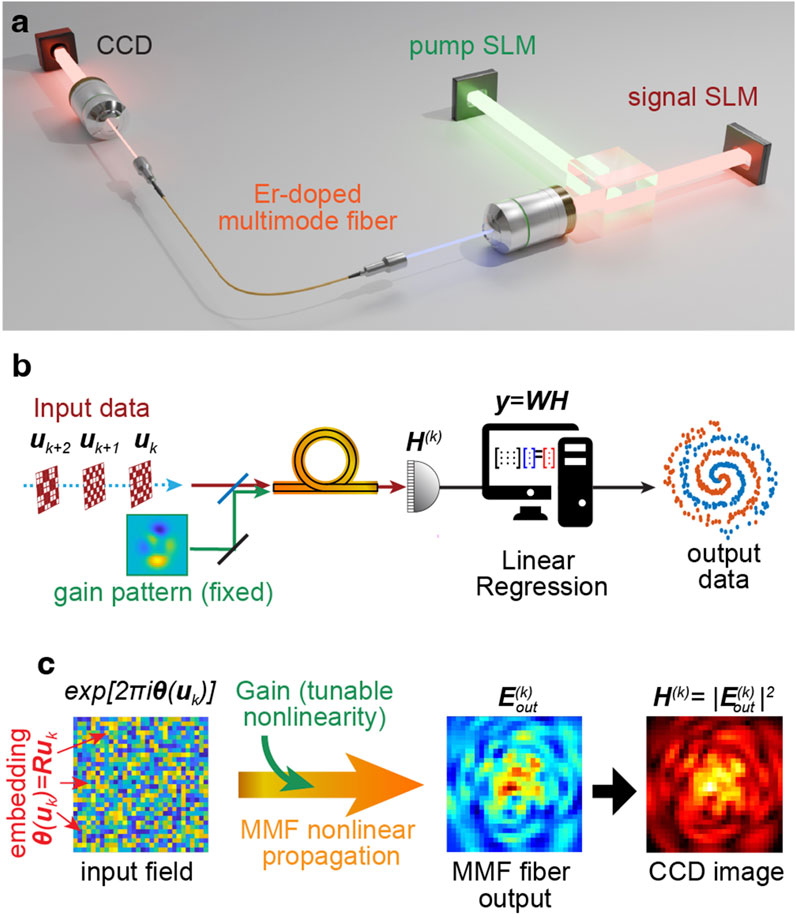
Figure 1. System configuration and computational framework. (a) Sketch of our photonic implementation, comprising an erbium-doped multimode fibre, two spatial light modulators (SLM) for the signal (red beam) and pump (green beam) fields, and a CCD camera. The signal and pump beams are injected on the same facet of the fibre and co-propagate across the fibre. The field at the output facet is imaged on the CCD array. The physical parameters are detailed in Supplementary Section S2. (b) Illustration of our computational framework, where the input data
2.2 Computational framework
Our system, sketched in Figure 1b, is designed to complete supervised learning tasks through the ELM computational framework (Maass et al., 2002; Maass et al., 2007). Consider a dataset
where
Here,
where
where
In our system, the ELM hidden layer is embodied by the transmission modes of the multimode fibre, which, in the presence of structured external pumping, evolve according to a nonlinear set of coupled Maxwell-Bloch equations (Totero Gongora et al., 2017; Totero Gongora et al., 2016) (see Supplementary Section S1 for a complete derivation of the model). Following standard approaches (Buck, 2004; Trinel et al., 2017), we express the signal and pump fields in the fibre as a superposition of Linearly Polarised (LP)-modes
where
In our scheme, shown in Figures 1b,c the input data
where
where
Upon propagation under Equation 5, the electric field distribution of the signal beam at the output facet of the fibre
For simplicity, we assume that the CCD camera detects the intensity of the field defined in Equation 9 at the output, namely
Finally, to construct the ELM hidden layer matrix
2.3 Machine learning tasks
2.3.1 Nonlinear regression
As a first regression task, we consider the interpolation of one-dimensional nonlinear functions of an input variable
where
where
2.3.2 Spiral classification dataset
As a first step towards more complex tasks, we consider the spiral classification dataset (McCaul et al., 2025a; Saeed et al., 2025). The dataset consists of two spirals in the
where
where
2.3.3 Linear and nonlinear time-series prediction (non-autonomous)
As a final example of the capabilities of our system, we considered two variations of the Mackey-Glass time series prediction task (Appeltant et al., 2011). The Mackey-Glass equation is a well-known chaotic time series that can be used to test the performance of nonlinear prediction algorithms and is defined as follows:
where
Time-series prediction is widely considered the cornerstone of RC systems, and it relies on an internal memory mechanism commonly implemented in terms of recurrent connections (Goldmann et al., 2020). For systems lacking internal memory, as in the case of our gain-controlled photonic reservoir, artificial memory must be engineered through delay embedding in the encoding or readout matrix. The standard approach in feed-forward photonic RC systems is to close the feedback loop by feeding the output into the subsequent input (Rafayelyan et al., 2020; Dong et al., 2020a). This self-feedback transforms the system into a recurrent network, endowing it with the fading memory—or echo property—characteristic of echo state networks, thereby compensating for the speed mismatch between the light propagation and the slower electronic encoding (SLM) and decoding (CCD) hardware (Gallicchio and Micheli, 2017; Jaeger and Haas, 2004). However, adding further light structuring to our system raises questions beyond the scope of this paper, such as “What is the optimal MMF mode distribution that should carry the previous output information, thereby making the network memory fade controllably?” As our focus remains on characterising an optimal nonlinear regime by structuring the signal to encode data and the pump to tune the RC nonlinear transformation, we prefer to utilise a different strategy. A recent post-processing method for delay embedding, developed by Jaurigue et al. (2025), offers an alternative to making the system autonomous while maintaining the agile feed-forward structure of the ELM: instead of routing a delayed version of the optical output back into the input, we chain a delayed version of the readout matrix
with
As an initial scenario, we consider a one-step prediction task, where the goal is to predict the next value of the time series given the previous values, namely,
3 Results
3.1 Gain response and nonlinear landscape
To capture the nonlinear response of the system, we first analyse the gain experienced by the signal field as a function of the signal
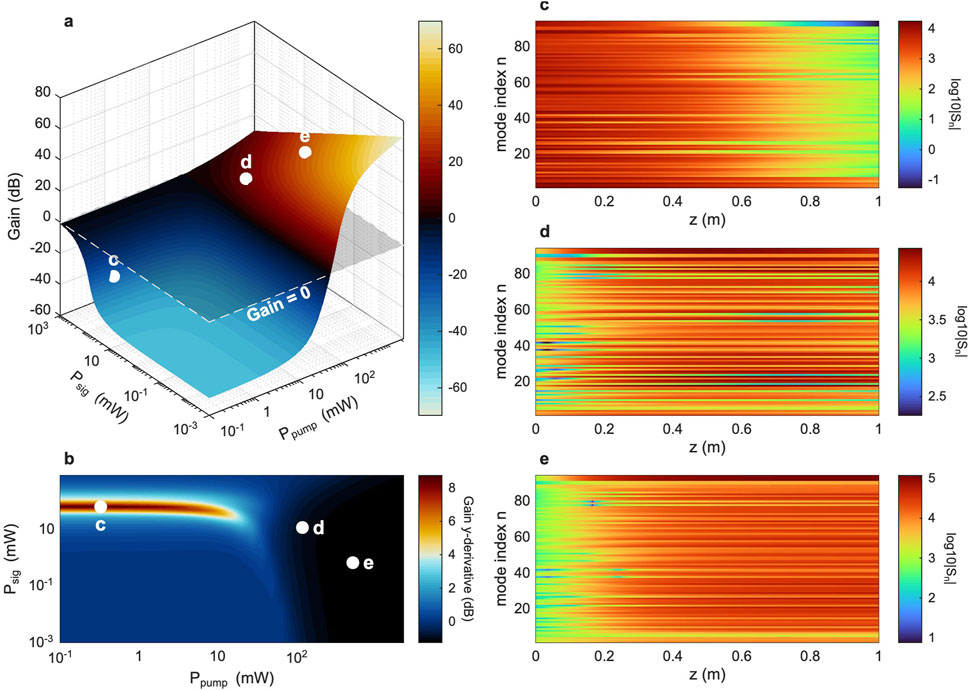
Figure 2. Gain profile and nonlinear regimes. (a) Three-dimensional plot of the total gain
Since the input data is encoded in the signal beam, it is instructive to analyse the variation of gain experienced by the signal for fixed pump power. This can easily be computed as a derivative of the gain with respect to the signal power. The results are shown in Figure 2b, where we show a two-dimensional map of the derivative
3.2 Nonlinear regression
As an initial task, we consider the interpolation of the sinc function defined by Equation 11 in the first paragraph of Section 2.3, with related embedding function in Equation 12. This task is beneficial for assessing the nonlinear expressivity of the system. The results for the case
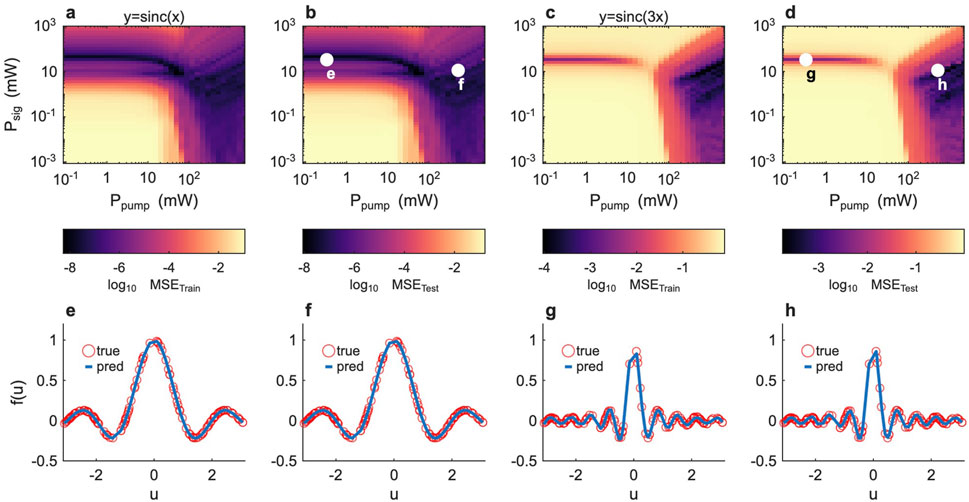
Figure 3. Nonlinear Regression. (a,b) Training (a) and Testing (b) MSE error for the task
To further assess the expressivity of the reservoir, we considered a second, more challenging regression task on the same reservoir realisation by modifying the target function parameter to
3.3 Classification
While nonlinear regression tasks can help assess the expressivity of the system, they do not necessarily reveal the nonlinear separation capabilities of the reservoir. The spiral classification defined by Equation 13 - with an embedding function given by Equation 14 - serves as a benchmark of the system nonlinear separability on more complex tasks. An example dataset is shown in Figure 4a, where we plot the two spirals in the
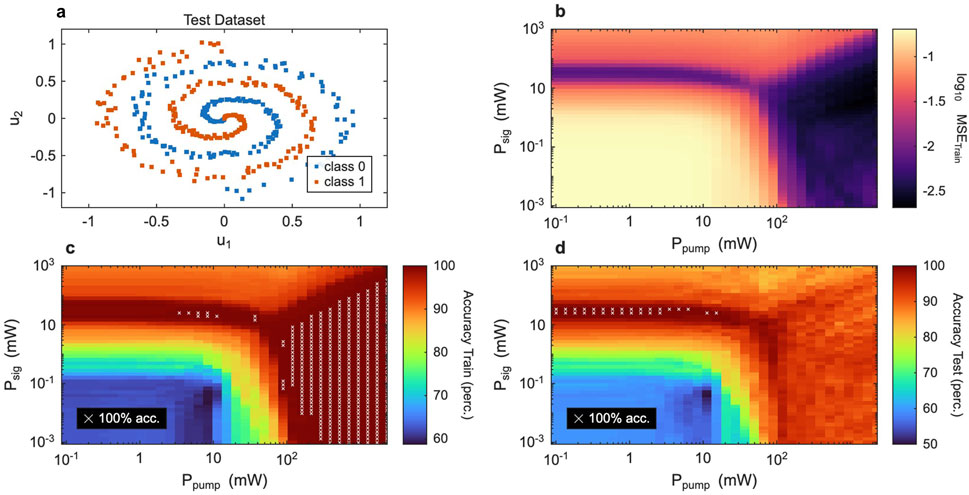
Figure 4. Spiral dataset classification. (a) Test dataset for the spiral dataset as defined by Equation 13. The two spiral arms are denoted as blue dots (class
3.4 Time-series prediction
To conclude our system benchmarking, we consider the linear and nonlinear (i.e., cubic) variations of the Mackey-Glass time series, non-autonomous prediction described in the final part of Section 2.3. The dynamical system is defined by Equation 15, and the related embedding function is in Equation 12.
The results for
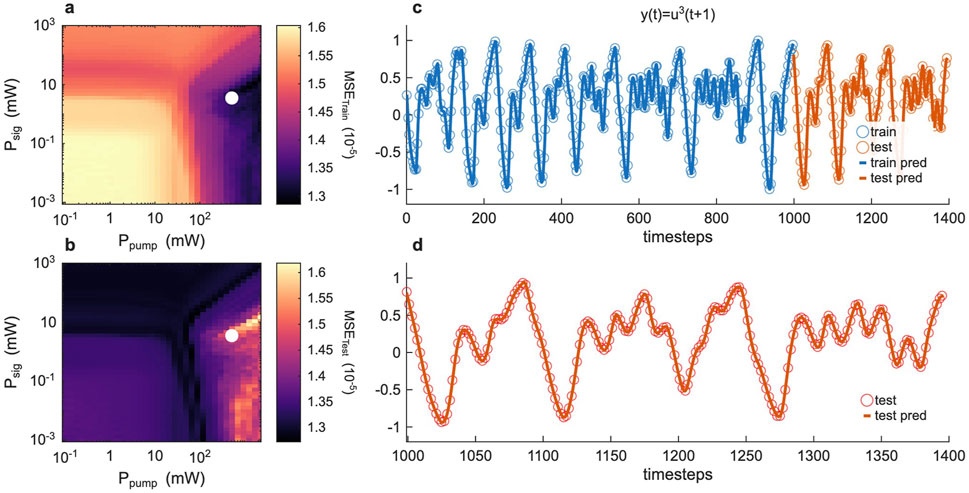
Figure 5. Non-autonomous time-series prediction, linear case (a,b) Training (a) and Testing (b) MSE error for the task
The results for
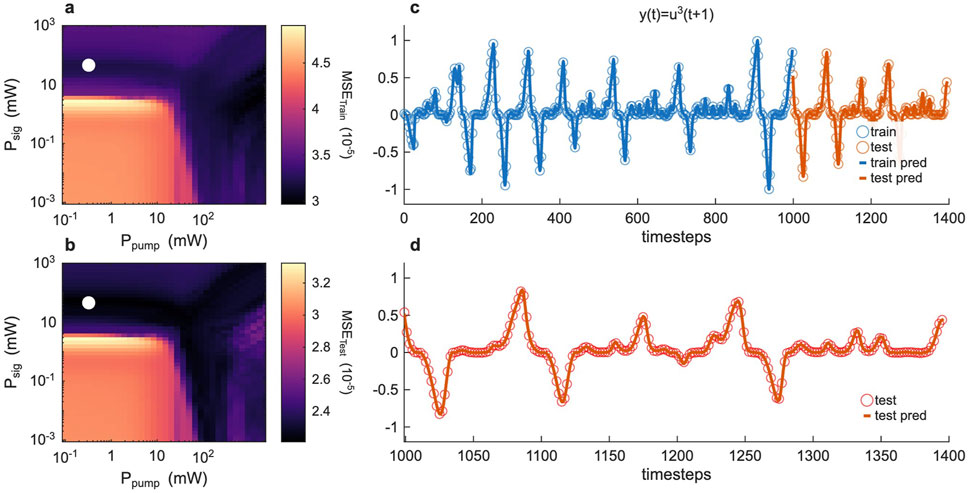
Figure 6. Non-autonomous time-series prediction, nonlinear case. (a,b) Training (a) and Testing (b) MSE error for the task
4 Discussion
In summary, across all tasks – static function approximation, binary classification, and temporal prediction – the reservoir consistently performs best in an intermediate regime of operation. Specifically, configurations with moderate gain and high sensitivity (near the gain threshold) yield the lowest errors, whereas too little nonlinearity (low power) or excessive nonlinearity (deep into gain saturation) degrade performance. This robust trend suggests an underlying principle governing optimal reservoir performance, which we explore next by analysing the system’s expressivity and complexity.
4.1 Readout analysis: linear algebra properties
At the core of our photonic reservoir lies the combination of controllable nonlinear transformations and separability enabled by the internal dynamics of the multimode fibre. The physical properties of the transformation directly map into the readout matrix
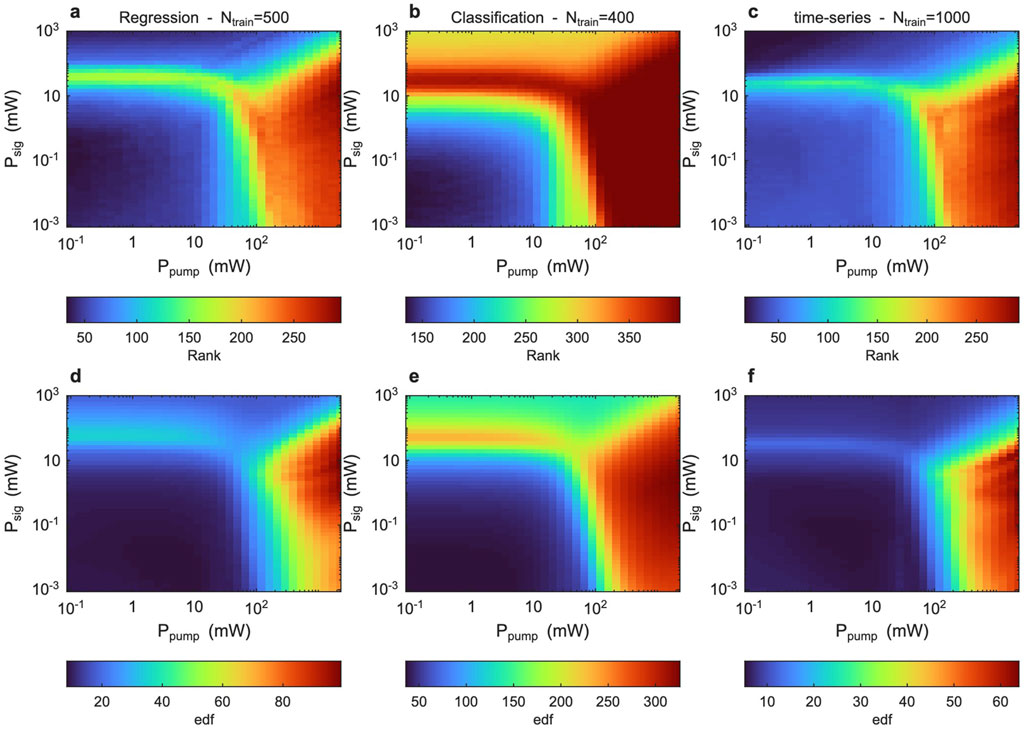
Figure 7. Linear Algebra metrics of the readout matrix
In the presence of ridge regularisation, however, the inclusion of a penalisation term automatically forces the rank of the matrices to be near maximal, as even near-singular directions in
where
In summary, the matrix rank reveals how well
The trade-off can be clearly appreciated by comparing our analysis to the prediction results for each task (cf. Figures 3–6). For the
4.2 The role of complexity
In RC, learning occurs only after propagation in the reservoir via linear regression, and the task target is never part of the encoding and processing. As shown in our results, in fact, an identical reservoir readout can accommodate different tasks, suggesting that successful computations not only originate from intrinsic properties of the readout (or design) matrix
Linear algebraic metrics such as rank, conditioning, and effective degrees of freedom provide valuable but incomplete insights into the reservoir computational performance, and they mainly offer guidance on the ability of the system to fit the training data and do not fully capture the underlying dynamical complexity that dictates performance in nonlinear tasks. To address this limitation, we analysed the reservoir output using algorithmic complexity, expressed by the Kolmogorov Complexity (KC), which measures the structured complexity or regularity of the reservoir-generated features.
The KC measures the algorithmic randomness of a string of bits, which is informally defined as the length of the shortest program that can produce that specific string of bits. While a unique definition of KC is not readily available, several approaches have been proposed, which are mostly dependent on the type of data under consideration. Following recent results in the analysis of pattern formation in nonlinear photonic systems (Perego et al., 2022), we approximate the KC of our reservoir processing via the Lempel–Ziv algorithm as implemented by Kaspar and Schuster (Kaspar and Schuster, 1987).
In this approach, the value of each output pixel is binarised relative to its mean (1 above mean and 0 otherwise), and the resulting binary pattern is analysed for compressibility. This initial complexity count is then normalised by the complexity of a random binary pattern of the same size
We compute two different versions of the KC following the procedures detailed in Supplementary Section S4. If the mean is computed across the sample space (average the value of the pixel across all samples), we are computing the feature KC. If the mean is computed across the feature space (average the value of the pixel across all pixels for a given sample), we obtain the sample KC. In brief, sample KC characterises complexity across spatial features (pixels) for each individual reservoir output (sample), whereas feature KC measures complexity across samples for each spatial feature (pixel). Here, we primarily focus on sample KC as it directly captures how structured (compressible) or random (incompressible) each reservoir output pattern is, and thus correlates closely with the quality of reservoir transformations relevant for task performance. The results for the sample KC are shown in Figure 8, while the feature KC plots are in Supplementary Figure S9.
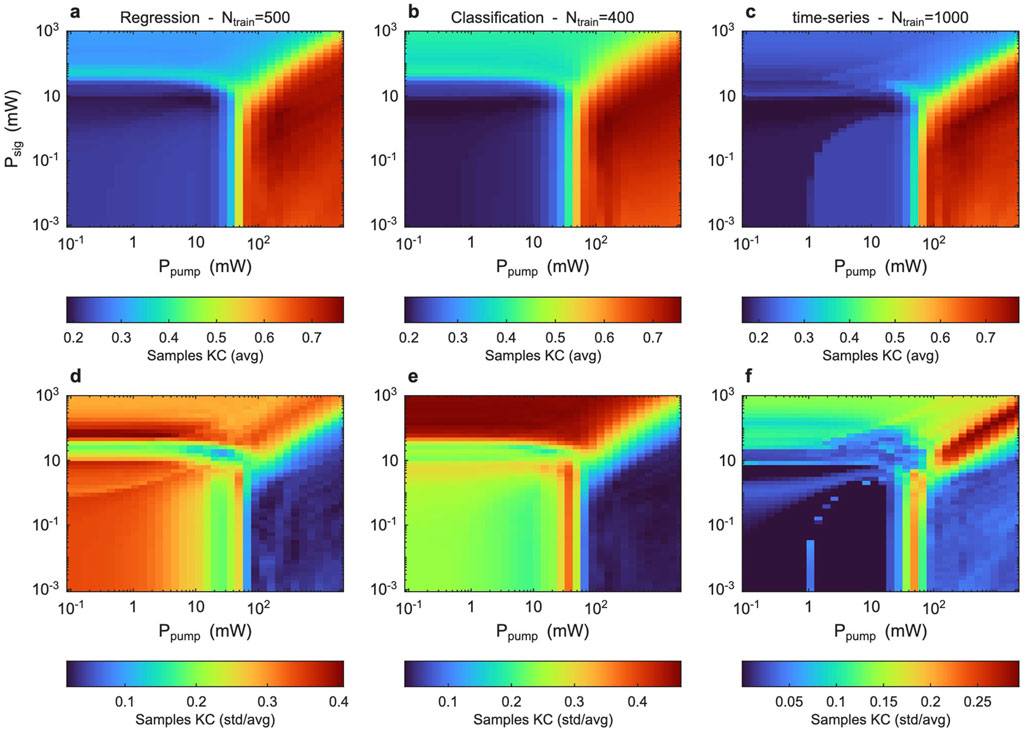
Figure 8. Sample Kolmogorov Complexity (KC) of the readout matrix
Figures 8a–c illustrate the normalised sample KC averaged across all samples, computed as a function of pump and signal powers for each computational task. A clear and consistent pattern emerges: in regimes of low optical power, the KC values are substantially below unity, indicating highly structured (overly regular) reservoir responses. This aligns with poor task performance due to insufficient nonlinearity in the reservoir transformations. Conversely, in regimes of excessively high pump and signal power—corresponding to chaotic or strongly saturated dynamics—the KC approaches unity, reflecting output patterns that resemble random noise. Such randomness provides high expressivity but limits generalisation, resulting in suboptimal task accuracy. To quantify the KC variability across samples, we also compute the standard deviation of the KC values (Figures 8d–f). The standard deviation is normalised by the mean KC value to provide a relative measure of variability. This analysis reveals that the KC variability is significantly lower in the optimal regime, indicating that the reservoir outputs are not only structured but also exhibit consistent patterns across samples.
It is important to note that KC is a finer measure of order/disorder than simple statistical metrics. Kolmogorov algorithmic complexity can detect the emergence of subtle structures in high-dimensional nonlinear systems that other measures might miss. For instance, a binary output pattern might have high Shannon entropy (each pixel is 0/1 50% of the time) but still be highly structured (e.g., repeated patterns), yielding a KC well below 1. The sub-unity KC captures this hidden regularity, whereas an entropy measure could mistakenly suggest “maximal randomness.” Essentially, KC
In this context, the KC provides a metric that is closer to the spectral radius or Lyapunov coefficients in time-series analysis and time-dependent reservoir systems ruled by ordinary differential equations (Li and Vitányi, 2019). In echo state networks, for instance, the spectral radius of the reservoir matrix needs to be carefully tuned to balance stability and chaos (Lukoševičius et al., 2012). Here, the KC of the outputs serves a similar role: it quantitatively reflects where our system lies on the spectrum from linear, nonlinear, and chaotic. Specifically, KC
5 Conclusion
In this work, we tackle the challenge of nonlinear tunability in photonic reservoir computing by designing a single system that can adapt its nonlinearity and complexity to different tasks. Using gain-controlled multimode fibre and wavefront encoding, we demonstrated that simply adjusting pump and signal powers provides such tunability, effectively reconfiguring the nonlinear operating regime of the reservoir on demand. Through simulations on regression, classification, and time-series benchmarks, we found a consistent trend: an intermediate regime near the gain threshold yields optimal performance, whereas regimes that are too linear or overly nonlinear underperform. A central contribution of this work is linking the reservoir computing performance to the Kolmogorov complexity of its outputs. We showed that in the optimal regime, the reservoir generates outputs with high algorithmic structure, detectable as a sub-unity Kolmogorov complexity, indicating maximal exploitation of nonlinear dynamics to produce informative features. Conventional metrics (including rank, effective degrees of freedom, and condition number) alone could not fully explain the learning performance in the nonlinear regime, whereas the complexity measure provided critical insight into why the ‘just-right’ amount of chaos is best. Unlike conventional metrics, in fact, the KC assesses the reservoir’s intrinsic output diversity: since the reservoir is not trained toward any one task while processing the dataset, it should produce a wealth of structured input transformations so that the linear readout can adapt to any required function. In summary, all metrics are important pieces of the puzzle: rank, conditioning, and
Data availability statement
The datasets presented in this study can be found in online repositories. The names of the repository/repositories and accession number(s) can be found below: https://doi.org/10.17028/rd.lboro.29482847. Numerical codes are available from the corresponding author upon reasonable request.
Author contributions
GM: Conceptualization, Methodology, Resources, Supervision, Writing – original draft, Writing – review and editing. LO: Writing – review and editing, Software, Visualization. JT: Data curation, Software, Visualization, Writing – review and editing, Conceptualization, Formal Analysis, Funding acquisition, Investigation, Methodology, Project administration, Resources, Supervision, Validation, Writing – original draft.
Funding
The author(s) declare that financial support was received for the research and/or publication of this article. This work was supported by the UK Engineering and Physical Sciences Research Council (EPSRC, Grant number EP/W028344/1), the UK Research and Innovation (UKRI) Horizon Europe guarantee scheme for the QRC-4-ESP project (Grant number 10108296), the European Union and the European Innovation Council through the Horizon Europe project QRC-4-ESP (Grant Agreement no. 101129663). LO acknowledges support from The Leverhulme Trust (Leverhulme Early Career Fellowship ECF-2023-315). Sulis is funded by EPSRC Grant EP/T022108/1 and the HPC Midlands+ consortium.
Acknowledgments
This paper acknowledges the use of the Lovelace HPC service at Loughborough University. Calculations were also performed using the Sulis Tier 2 HPC platform hosted by the Scientific Computing Research Technology Platform at the University of Warwick. We thank Dr Maxwell Rowley for discussions on the gain dynamics in fibre systems and Dr Gerard McCaul for insightful discussions on the Kolmogorov Complexity analysis and interpretation.
Conflict of interest
Author GM was employed by LumiAIres Ltd.
The remaining authors declare that the research was conducted in the absence of any commercial or financial relationships that could be construed as a potential conflict of interest.
Generative AI statement
The author(s) declare that no Generative AI was used in the creation of this manuscript.
Publisher’s note
All claims expressed in this article are solely those of the authors and do not necessarily represent those of their affiliated organizations, or those of the publisher, the editors and the reviewers. Any product that may be evaluated in this article, or claim that may be made by its manufacturer, is not guaranteed or endorsed by the publisher.
Supplementary material
The Supplementary Material for this article can be found online at: https://www.frontiersin.org/articles/10.3389/fnano.2025.1631564/full#supplementary-material
References
Agrawal, G. P., and Premaratne, M. (2011). Light propagation in gain Media_Optical amplifiers. Cambridge University Press.
Amodei, D., Hernandez, D., Sastry, G., Clark, J., Brockman, G., and Sutskever, I. (2018). AI and compute. Available online at: https://openai.com/research/ai-and-compute.Tech.rep.,OpenAI.
Appeltant, L., Soriano, M. C., Van der Sande, G., Danckaert, J., Massar, S., Dambre, J., et al. (2011). Information processing using a single dynamical node as complex system. Nat. Commun. 2, 468. doi:10.1038/ncomms1476
Axler, S. (2015). “Linear algebra done right,” in Undergraduate texts in mathematics. Cham: Springer International Publishing. doi:10.1007/978-3-319-11080-6
Bertschinger, N., and Natschläger, T. (2004). Real-time computation at the edge of chaos in recurrent neural networks. Neural Comput. 16, 1413–1436. doi:10.1162/089976604323057443
Bhardwaj, E., Alexander, R., and Becker, C. (2025). Limits to AI growth: the ecological and social consequences of scaling. arXiv. doi:10.48550/arXiv.2501.17980
Brunner, D., Shastri, B. J., Qadasi, M. A. A., Ballani, H., Barbay, S., Biasi, S., et al. (2025). Roadmap on neuromorphic photonics. arXiv. doi:10.48550/arXiv.2501.07917
Buck, J. A. (2004). Fundamentals of optical fibers. Wiley series in pure and applied optics (Hoboken, NJ: Wiley-Interscience), 2.
Dale, M., Dewhirst, J., O’Keefe, S., Sebald, A., Stepney, S., and Trefzer, M. A. (2019). “The role of structure and complexity on reservoir computing quality,” in Unconventional computation and natural computation. Editors I. McQuillan, and S. Seki (Cham: Springer International Publishing), 11493, 52–64. doi:10.1007/978-3-030-19311-9_6
Dong, H., Jaurigue, L., and Lüdge, K. (2025). Time-multiplexed reservoir computing with quantum-dot lasers: impact of charge-carrier scattering timescale. Phys. status solidi (RRL) – Rapid Res. Lett. 19, 2400433. doi:10.1002/pssr.202400433
Dong, J., Ohana, R., Rafayelyan, M., and Krzakala, F. (2020b). Reservoir computing meets recurrent kernels and structured transforms. arXiv:2006.07310 cs, eess, Stat. doi:10.48550/arXiv.2006.07310
Dong, J., Rafayelyan, M., Krzakala, F., and Gigan, S. (2020a). Optical reservoir computing using multiple light scattering for chaotic systems prediction. IEEE J. Sel. Top. Quantum Electron. 26, 1–12. doi:10.1109/JSTQE.2019.2936281
Farhat, N. H., Psaltis, D., Prata, A., and Paek, E. (1985). Optical implementation of the Hopfield model. Appl. Opt. 24, 1469. doi:10.1364/AO.24.001469
Florentin, R., Kermene, V., Benoist, J., Desfarges-Berthelemot, A., Pagnoux, D., Barthélémy, A., et al. (2017). Shaping the light amplified in a multimode fiber. Light Sci. and Appl. 6, e16208. doi:10.1038/lsa.2016.208
Gallicchio, C., and Micheli, A. (2017). Echo state property of deep reservoir computing networks. Cogn. Comput. 9, 337–350. doi:10.1007/s12559-017-9461-9
Gartside, J. C., Stenning, K. D., Vanstone, A., Holder, H. H., Arroo, D. M., Dion, T., et al. (2022). Reconfigurable training and reservoir computing in an artificial spin-vortex ice via spin-wave fingerprinting. Nat. Nanotechnol. 17, 460–469. doi:10.1038/s41565-022-01091-7
Ghosh, S., Opala, A., Matuszewski, M., Paterek, T., and Liew, T. C. H. (2019). Quantum reservoir processing. npj Quantum Inf. 5, 35. doi:10.1038/s41534-019-0149-8
Gigan, S. (2022). Imaging and computing with disorder. Nat. Phys. 18, 980–985. doi:10.1038/s41567-022-01681-1
Goldmann, M., Köster, F., Lüdge, K., and Yanchuk, S. (2020). Deep time-delay reservoir computing: dynamics and memory capacity. Chaos An Interdiscip. J. Nonlinear Sci. 30, 093124. doi:10.1063/5.0017974
Haken, H., and Sauermann, H. (1963). Nonlinear interaction of laser modes. Z. für Phys. 173, 261–275. doi:10.1007/BF01377828
Hary, M., Brunner, D., Leybov, L., Ryczkowski, P., Dudley, J. M., and Genty, G. (2025). Principles and metrics of extreme learning machines using a highly nonlinear fiber. Nanophotonics. doi:10.1515/nanoph-2025-0012
Hastie, T. (2020). Ridge regularization: an essential concept in data science. Technometrics 62, 426–433. doi:10.1080/00401706.2020.1791959
Hastie, T., Tibshirani, R., and Friedman, J. (2009). The elements of statistical learning: data mining, inference, and prediction. Springer.
Hurtado, A., Romeira, B., Buckley, S., Cheng, Z., and Shastri, B. J. (2022). Emerging optical materials, devices and systems for photonic neuromorphic computing: introduction to special issue. Opt. Mater. Express 12, 4328. doi:10.1364/OME.477577
Jaeger, H., and Haas, H. (2004). Harnessing nonlinearity: predicting chaotic systems and saving energy in wireless communication. Science 304, 78–80. doi:10.1126/science.1091277
Jaurigue, J., Robertson, J., Hurtado, A., Jaurigue, L., and Lüdge, K. (2025). Post-processing methods for delay embedding and feature scaling of reservoir computers. Commun. Eng. 4, 10–13. doi:10.1038/s44172-024-00330-0
Jiménez-González, P., Soriano, M. C., and Lacasa, L. (2025). Leveraging chaos in the training of artificial neural networks. arXiv, 2506. doi:10.48550/arXiv.2506.08523
Jumper, J., Evans, R., Pritzel, A., Green, T., Figurnov, M., Ronneberger, O., et al. (2021). Highly accurate protein structure prediction with AlphaFold. Nature 596, 583–589. doi:10.1038/s41586-021-03819-2
Kaspar, F., and Schuster, H. G. (1987). Easily calculable measure for the complexity of spatiotemporal patterns. Phys. Rev. A 36, 842–848. doi:10.1103/PhysRevA.36.842
Kesgin, B. U., and Tegin, U. (2025). Photonic neural networks at the edge of spatiotemporal chaos in multimode fibers. Nanophotonics. doi:10.1515/nanoph-2024-0593
Kudithipudi, D., Schuman, C., Vineyard, C. M., Pandit, T., Merkel, C., Kubendran, R., et al. (2025). Neuromorphic computing at scale. Nature 637, 801–812. doi:10.1038/s41586-024-08253-8
Lee, O., Wei, T., Stenning, K. D., Gartside, J. C., Prestwood, D., Seki, S., et al. (2024). Task-adaptive physical reservoir computing. Nat. Mater. 23, 79–87. doi:10.1038/s41563-023-01698-8
Legenstein, R., and Maass, W. (2007). Edge of chaos and prediction of computational performance for neural circuit models. Neural Netw. 20, 323–334. doi:10.1016/j.neunet.2007.04.017
Li, M., and Vitányi, P. (2019). “An introduction to Kolmogorov complexity and its applications,” in Texts in computer science. Cham: Springer International Publishing. doi:10.1007/978-3-030-11298-1
Lukoševičius, M. (2012). “A practical guide to applying echo state networks,” in Neural networks: tricks of the trade. Editors G. Montavon, G. B. Orr, and K. R. Müller (Berlin, Heidelberg: Springer Berlin Heidelberg), 7700, 659–686. doi:10.1007/978-3-642-35289-8_36
Maass, W. (2011). Liquid state machines: motivation, theory, and applications. World Sci., 275–296. doi:10.1142/9781848162778_0008
Maass, W., Joshi, P., and Sontag, E. D. (2007). Computational aspects of feedback in neural circuits. PLOS Comput. Biol. 3, e165. doi:10.1371/journal.pcbi.0020165
Maass, W., Natschläger, T., and Markram, H. (2002). Real-time computing without stable states: a new framework for neural computation based on perturbations. Neural Comput. 14, 2531–2560. doi:10.1162/089976602760407955
Marcucci, G., Pierangeli, D., and Conti, C. (2020). Theory of neuromorphic computing by waves: machine learning by rogue waves, dispersive shocks, and solitons. Phys. Rev. Lett. 125, 093901. doi:10.1103/PhysRevLett.125.093901
Marković, D., Mizrahi, A., Querlioz, D., and Grollier, J. (2020). Physics for neuromorphic computing. Nat. Rev. Phys. 2, 499–510. doi:10.1038/s42254-020-0208-2
McCaul, G., Jacobs, K., and Bondar, D. I. (2023). Towards single atom computing via high harmonic generation. Eur. Phys. J. Plus 138, 123. doi:10.1140/epjp/s13360-023-03649-3
McCaul, G., Totero Gongora, J. S., Otieno, W., Savelev, S., Zagoskin, A., and Balanov, A. G. (2025b). Minimal quantum reservoirs with Hamiltonian encoding. arXiv:2505.22575. doi:10.48550/arXiv.2505.22575
McCaul, G., Tripathy, G., Marcucci, G., and Totero Gongora, J. S. (2025a). Unwrapping photonic reservoirs: enhanced expressivity via random fourier encoding over stretched domains. arXiv:2506.01410. doi:10.48550/arXiv.2506.01410
McMahon, P. L. (2023). The physics of optical computing. Nat. Rev. Phys. 5, 717–734. doi:10.1038/s42254-023-00645-5
Merolla, P. A., Arthur, J. V., Alvarez-Icaza, R., Cassidy, A. S., Sawada, J., Akopyan, F., et al. (2014). A million spiking-neuron integrated circuit with a scalable communication network and interface. Science 345, 668–673. doi:10.1126/science.1254642
Nerenberg, S., Neill, O. D., Marcucci, G., and Faccio, D. (2025). Photon number-resolving quantum reservoir computing. Opt. Quantum 3, 201–210. doi:10.1364/OPTICAQ.553294
Ng, W. K., Dranczewski, J., Fischer, A., Raziman, T. V., Saxena, D., Farchy, T., et al. (2024). Retinomorphic machine vision in a network laser. arXiv:2407.15558. doi:10.48550/arXiv.2407.15558
Olivieri, L., Cooper, A. R., Peters, L., Cecconi, V., Pasquazi, A., Peccianti, M., et al. (2025). Adiabatic energetic annealing via dual single-pixel detection in an optical nonlinear ising machine. ACS Photonics 12, 2896–2901. doi:10.1021/acsphotonics.4c02496
Owen-Newns, D., Jaurigue, L., Robertson, J., Adair, A., Jaurigue, J. A., Lüdge, K., et al. (2025). Photonic spiking neural network built with a single VCSEL for high-speed time series prediction. Commun. Phys. 8, 110–119. doi:10.1038/s42005-025-02000-9
Perego, A. M., Bessin, F., and Mussot, A. (2022). Complexity of modulation instability. Phys. Rev. Res. 4, L022057. doi:10.1103/PhysRevResearch.4.L022057
Pierangeli, D., Marcucci, G., and Conti, C. (2021). Photonic extreme learning machine by free-space optical propagation. Photonics Res. 9, 1446–1454. doi:10.1364/PRJ.423531
Pierangeli, D., Palmieri, V., Marcucci, G., Moriconi, C., Perini, G., De Spirito, M., et al. (2020). Living optical random neural network with three dimensional tumor spheroids for cancer morphodynamics. Commun. Phys. 3, 160–10. doi:10.1038/s42005-020-00428-9
Pierro, A., Heiney, K., Shrivastava, S., Marcucci, G., and Nichele, S. (2023). Optimization of a hydrodynamic computational reservoir through evolution. Proc. Genet. Evol. Comput. Conf. 23, 202–210. doi:10.1145/3583131.3590355
Psaltis, D., and Farhat, N. (1985). Optical information processing based on an associative-memory model of neural nets with thresholding and feedback. Opt. Lett. 10, 98. doi:10.1364/OL.10.000098
Rafayelyan, M., Dong, J., Tan, Y., Krzakala, F., and Gigan, S. (2020). Large-scale optical reservoir computing for spatiotemporal chaotic systems prediction, Phys. Rev. X 10, 041037. doi:10.1103/PhysRevX.10.041037
Rahmani, B., Oguz, I., Tegin, U., Hsieh, Jl, Psaltis, D., and Moser, C. (2022). Learning to image and compute with multimode optical fibers. Nanophotonics 11, 1071–1082. doi:10.1515/nanoph-2021-0601
Robertson, J., Hejda, M., Bueno, J., and Hurtado, A. (2020). Ultrafast optical integration and pattern classification for neuromorphic photonics based on spiking VCSEL neurons. Sci. Rep. 10, 6098. doi:10.1038/s41598-020-62945-5
Rowley, M., Hanzard, P. H., Cutrona, A., Bao, H., Chu, S. T., Little, B. E., et al. (2022). Self-emergence of robust solitons in a microcavity. Nature 608, 303–309. doi:10.1038/s41586-022-04957-x
Roy, K., Jaiswal, A., and Panda, P. (2019). Towards spike-based machine intelligence with neuromorphic computing. Nature 575, 607–617. doi:10.1038/s41586-019-1677-2
Saeed, S., Müftüoglu, M., Cheeran, G. R., Bocklitz, T., Fischer, B., and Chemnitz, M. (2025). Nonlinear inference capacity of fiber-optical extreme learning machines. ArXiv:2501.18894 [physics] [Preprint]. doi:10.48550/arXiv.2501.18894
Shastri, B. J., Tait, A. N., Ferreira de Lima, T., Pernice, W. H. P., Bhaskaran, H., Wright, C. D., et al. (2021). Photonics for artificial intelligence and neuromorphic computing. Nat. Photonics 15, 102–114. doi:10.1038/s41566-020-00754-y
Shekel, R., Sulimany, K., Resisi, S., Finkelstein, Z., Lib, O., Popoff, S. M., et al. (2024). Tutorial: how to build and control an all-fiber wavefront modulator using mechanical perturbations. J. Phys. Photonics 6, 033002. doi:10.1088/2515-7647/ad5774
Shishavan, N. S., Manuylovich, E., Kamalian-Kopae, M., and Perego, A. M. (2025). Optical neuromorphic computing based on chaotic frequency combs in nonlinear microresonators. arXiv:2501.17113. doi:10.48550/arXiv.2501.17113
Skalli, A., Sunada, S., Goldmann, M., Gebski, M., Reitzenstein, S., Lott, J. A., et al. (2025). Model-free front-to-end training of a large high performance laser neural network. arXiv:2503.16943. doi:10.48550/arXiv.2503.16943
Sperber, T., Billault, V., Dussardier, B., Gigan, S., and Sebbah, P. (2020). Gain as configurable disorder-adaptive pumping for control of multimode fiber amplifiers and lasers. arXiv:2008.04085 Phys. doi:10.48550/arXiv.2008.04085
Sperber, T., Billault, V., Sebbah, P., and Gigan, S. (2019). Wavefront shaping of the pump in multimode fiber amplifiers; the gain-dependent transmission matrix. arXiv:1911.07812 Phys. doi:10.48550/arXiv.1911.07812
Stone, A. D., Tureci, H. E., and Schwefel, H. G. (2005). Mode competition and output power from regular and chaotic dielectric cavity lasers. Front. Opt. (Tucson, Ariz. OSA), FWQ1. doi:10.1364/FIO.2005.FWQ1
Talukder, R., Skalli, A., Porte, X., Thorpe, S., and Brunner, D. (2025). A spiking photonic neural network of 40000 neurons, trained with latency and rank-order coding for leveraging sparsity. Neuromorphic Comput. Eng. 5, 034003. doi:10.1088/2634-4386/addee7
Tanaka, G., Yamane, T., Héroux, J. B., Nakane, R., Kanazawa, N., Takeda, S., et al. (2019). Recent advances in physical reservoir computing: a review. Neural Netw. 115, 100–123. doi:10.1016/j.neunet.2019.03.005
Teğin, U., Yıldırım, M., Oğuz, İ., Moser, C., and Psaltis, D. (2021). Scalable optical learning operator. Nat. Comput. Sci. 1, 542–549. doi:10.1038/s43588-021-00112-0
Totero Gongora, J. S., Miroshnichenko, A. E., Kivshar, Y. S., and Fratalocchi, A. (2017). Anapole nanolasers for mode-locking and ultrafast pulse generation. Nat. Commun. 8, 15535. doi:10.1038/ncomms15535
Totero Gongora, J.S., Miroshnichenko, A.E., Kivshar, Y.S., and Fratalocchi, A. (2016), Energy equipartition and unidirectional emission in a spaser nanolaser. Laser and Photonics Reviews, 10: 432–440. doi:10.1002/lpor.201500239
Trinel, J. B., Cocq, G. L., Quiquempois, Y., Andresen, E. R., Vanvincq, O., and Bigot, L. (2017). Theoretical study of gain-induced mode coupling and mode beating in few-mode optical fiber amplifiers. Opt. Express 25, 2377–2390. doi:10.1364/OE.25.002377
Valensise, C. M., Grecco, I., Pierangeli, D., and Conti, C. (2022). Large-scale photonic natural language processing. Photonics Res. 10, 2846–2853. doi:10.1364/PRJ.472932
Wang, D., Nie, Y., Hu, G., Tsang, H. K., and Huang, C. (2024a). Ultrafast silicon photonic reservoir computing engine delivering over 200 TOPS. Nat. Commun. 15, 10841. doi:10.1038/s41467-024-55172-3
Wang, H., Hu, J., Baek, Y., Tsuchiyama, K., Joly, M., Liu, Q., et al. (2024c). Optical next generation reservoir computing. arXiv:2404.07857. doi:10.48550/arXiv.2404.07857
Wang, H., Hu, J., Morandi, A., Nardi, A., Xia, F., Li, X., et al. (2024d). Large-scale photonic computing with nonlinear disordered media. Nat. Comput. Sci. 4, 429–439. doi:10.1038/s43588-024-00644-1
Wang, Z., Müller, K., Filipovich, M., Launay, J., Ohana, R., Pariente, G., et al. (2024b). Streamlined optical training of large-scale modern deep learning architectures with direct feedback alignment. arXiv:2409.12965. doi:10.48550/arXiv.2409.12965
Wei, X., Jing, J. C., Shen, Y., and Wang, L. V. (2020). Harnessing a multi-dimensional fibre laser using genetic wavefront shaping. Light Sci. and Appl. 9, 149. doi:10.1038/s41377-020-00383-8
Xia, F., Kim, K., Eliezer, Y., Han, S., Shaughnessy, L., Gigan, S., et al. (2024). Nonlinear optical encoding enabled by recurrent linear scattering. Nat. Photonics 18, 1067–1075. doi:10.1038/s41566-024-01493-0
Keywords: reservoir computing (RC), optical computing algorithms, photonic neural network, multimode fibre (MMF), erbium-doped fibre (EDF), nonlinear optics and laser properties, neuromorphic computing component, photonic machine learning
Citation: Marcucci G, Olivieri L and Totero Gongora JS (2025) Optimising complexity and learning for photonic reservoir computing with gain-controlled multimode fibres. Front. Nanotechnol. 7:1631564. doi: 10.3389/fnano.2025.1631564
Received: 19 May 2025; Accepted: 08 July 2025;
Published: 15 August 2025.
Edited by:
Lorenzo De Marinis, Sant’Anna School of Advanced Studies, ItalyReviewed by:
Yang Ming, Changshu Institute of Technology, ChinaGiancarlo Ruocco, Italian Institute of Technology (IIT), Italy
Copyright © 2025 Marcucci, Olivieri and Totero Gongora. This is an open-access article distributed under the terms of the Creative Commons Attribution License (CC BY). The use, distribution or reproduction in other forums is permitted, provided the original author(s) and the copyright owner(s) are credited and that the original publication in this journal is cited, in accordance with accepted academic practice. No use, distribution or reproduction is permitted which does not comply with these terms.
*Correspondence: Juan Sebastian Totero Gongora, ai50b3Rlcm8tZ29uZ29yYUBsYm9yby5hYy51aw==
 Giulia Marcucci
Giulia Marcucci Luana Olivieri
Luana Olivieri Juan Sebastian Totero Gongora
Juan Sebastian Totero Gongora